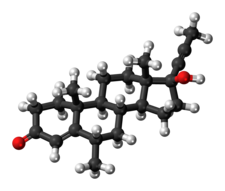
Back دیمتیسترون AZB دیمتیسترون Persian Dimetisteron Serbo-Croatian Dimetisteron Serbian 二甲炔酮 Chinese
 | |
 | |
| Clinical data | |
|---|---|
| Trade names | Lutagan, Secrosteron, others |
| Other names | Dimethindrone; 6α,21-Dimethylethisterone; 6α,21-Dimethyl-17α-ethynyltestosterone; 17α-Ethynyl-6α,21-dimethylandrost-4-en-17β-ol-3-one; 6α,21-Dimethyl-17β-hydroxy-17α-pregn-4-en-20-yn-3-one |
| Routes of administration | By mouth |
| Drug class | Progestogen; Progestin |
| Identifiers | |
| |
| CAS Number | |
| PubChem CID | |
| ChemSpider | |
| UNII | |
| CompTox Dashboard (EPA) | |
| ECHA InfoCard | 100.001.106 |
| Chemical and physical data | |
| Formula | C23H32O2 |
| Molar mass | 340.507 g·mol−1 |
| 3D model (JSmol) | |
| |
| |
Dimethisterone, formerly sold under the brand names Lutagan and Secrosteron among others, is a progestin medication which was used in birth control pills and in the treatment of gynecological disorders but is now no longer available.[1][2][3][4] It was used both alone and in combination with an estrogen.[1][5] It is taken by mouth.[6]
Side effects of dimethisterone are similar to those of other progestins. When used in combination with high doses of an estrogen, an increased risk of endometrial cancer can occur.[7] Dimethisterone is a progestin, or a synthetic progestogen, and hence is an agonist of the progesterone receptor, the biological target of progestogens like progesterone.[8][9][10] It has some antimineralocorticoid activity and no other important hormonal activity.[8][9][10]
Dimethisterone was first described and was introduced for medical use in 1959.[1][8] It started being used in birth control pills in 1965.[5] However, due to its low potency and consequent inability to prevent the increased risk of endometrial cancer with estrogens, dimethisterone was soon discontinued for such purposes.[7]
- ^ a b c Elks J (14 November 2014). The Dictionary of Drugs: Chemical Data: Chemical Data, Structures and Bibliographies. Springer. pp. 430–. ISBN 978-1-4757-2085-3.
- ^ Paoletti R, Pasetto N, Ambrus JL (6 December 2012). The Menopause and Postmenopause: The Proceedings of an International Symposium held in Rome, June 1979. Springer Science & Business Media. pp. 374–. ISBN 978-94-011-7230-1.
- ^ Voigt LF, Weiss NS (6 December 2012). "Epidemiology of endometrial cancer". In Surwit EA, Alberts D (eds.). Endometrial Cancer. Springer Science & Business Media. pp. 11–. ISBN 978-1-4613-0867-6.
- ^ Patterson R (21 December 2012). Drugs in Litigation: Damage Awards Involving Prescription and Nonprescription Drugs. LexisNexis. pp. 483–484. ISBN 978-0-327-18698-4.
- ^ a b Cite error: The named reference
Publishing2013was invoked but never defined (see the help page). - ^ Gadappa S, Yelikar K, Deshpande S (7 May 2015). "Drugs in Obstetrics and Gynecology". In Yelikar K (ed.). Practical Cases in Obstetrics & Gynecology. JP Medical Ltd. pp. 98–. ISBN 978-93-5090-536-4.
- ^ a b Cite error: The named reference
BarakatMarkman2009was invoked but never defined (see the help page). - ^ a b c Cite error: The named reference
pmid13814263was invoked but never defined (see the help page). - ^ a b Cite error: The named reference
MorganJones1959was invoked but never defined (see the help page). - ^ a b Cite error: The named reference
Jucker2013was invoked but never defined (see the help page).